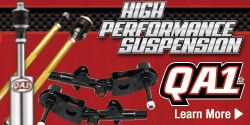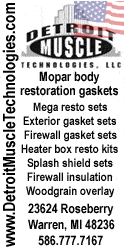KitCarlson
Well-Known Member
I am a frugal do it yourself person. I have restored several older fuel injected cars in the past. I have managed good results with the old reliable Bosch style injectors. I have not flow tested, but the vehicles ran very well. The Bosch solenoid injectors were first used by VW Type3 and Porsche 914's in 1969, and later by MOPAR in the 80's. Many say if the bodies do not leak from mechanical abuse, or freezing with water in them, they can be cleaned, and a high percentage will pass flow tests.
The injectors have two different solenoid types that vary by impedance. The low impedance measure about 2.3 Ohms. They are peak and hold injectors. The injectors are typically operated by applying full voltage for an instant, then reducing the holding current. The simplest way is a 6 Ohm resistor in series with the injector with a 12V supply. There are more details but will save all that for later. The high impedance saturated injectors measure 15 Ohms, they can be driven directly from 12V.
Injectors typically are limited to 85% on time and require fuel flow for cooling. A few clicks for test will not hurt an injector, just use a 6 Ohm series resistor on low impedance injectors, or an adjustable power supply capable of a couple amps at 5V.
Bench testing the solenoids for a click, reveals if an injector is stuck or not. I often find that injectors that have been left on a manifold with rails holding gas are often stuck when the fuel dries up and turns to varnish.
I have found looping a tubing from injector inlet to outlet with CRC Brakleen inside works wonders in a few minutes of shaking. It is a simple and clean way to do the first clean, to free a stuck injector.
Injector inlet filter baskets are removed by using a correct sized screw and pulling with pliers. The pintle covers are removed by applying a 5/16" hose and pulling quickly. If that does not work, snug it first with a hose clamp. New inlet filters and pintle caps are available from vendors on Ebay.
I have purchased a Harbor Freight ultrasonic cleaner. I am just starting to experiment with it on some 40 year old injectors.
I have not built the flow tester, but I have most parts. I will use my EMS2, normally used for fuel injection and ignition, to drive four injectors for test conditions of various pulse duration, frequency and counts. I have developed three different flow benches for diesel injectors, so I have experience with all that. I have a few hours of code development ahead of me to make what is needed for this situation. I will have have a PC interface for test configuration, and a switch or two via the timing sensor interface for manual start/stop control. Fuel pressure control will be via an adjustable regulator, or a rising rate regulator and a Mity-Vac hand pump. I might add pressure measurement however a stainless steel pressure sensor is $100. I have one in my turbo Omni, but do not want to take it out. I am more interested in equal flow for each, without pintle leaks at this time.
I will start building the flow bench in a day or two when it warms up. I am working on the software now.
Below is some of the "junk" parts and equipment I plan to use.
Please free to comment. I am learning as I go. Not sure of best methods for ultrasonic cleaning.
The injectors have two different solenoid types that vary by impedance. The low impedance measure about 2.3 Ohms. They are peak and hold injectors. The injectors are typically operated by applying full voltage for an instant, then reducing the holding current. The simplest way is a 6 Ohm resistor in series with the injector with a 12V supply. There are more details but will save all that for later. The high impedance saturated injectors measure 15 Ohms, they can be driven directly from 12V.
Injectors typically are limited to 85% on time and require fuel flow for cooling. A few clicks for test will not hurt an injector, just use a 6 Ohm series resistor on low impedance injectors, or an adjustable power supply capable of a couple amps at 5V.
Bench testing the solenoids for a click, reveals if an injector is stuck or not. I often find that injectors that have been left on a manifold with rails holding gas are often stuck when the fuel dries up and turns to varnish.
I have found looping a tubing from injector inlet to outlet with CRC Brakleen inside works wonders in a few minutes of shaking. It is a simple and clean way to do the first clean, to free a stuck injector.
Injector inlet filter baskets are removed by using a correct sized screw and pulling with pliers. The pintle covers are removed by applying a 5/16" hose and pulling quickly. If that does not work, snug it first with a hose clamp. New inlet filters and pintle caps are available from vendors on Ebay.
I have purchased a Harbor Freight ultrasonic cleaner. I am just starting to experiment with it on some 40 year old injectors.
I have not built the flow tester, but I have most parts. I will use my EMS2, normally used for fuel injection and ignition, to drive four injectors for test conditions of various pulse duration, frequency and counts. I have developed three different flow benches for diesel injectors, so I have experience with all that. I have a few hours of code development ahead of me to make what is needed for this situation. I will have have a PC interface for test configuration, and a switch or two via the timing sensor interface for manual start/stop control. Fuel pressure control will be via an adjustable regulator, or a rising rate regulator and a Mity-Vac hand pump. I might add pressure measurement however a stainless steel pressure sensor is $100. I have one in my turbo Omni, but do not want to take it out. I am more interested in equal flow for each, without pintle leaks at this time.
I will start building the flow bench in a day or two when it warms up. I am working on the software now.
Below is some of the "junk" parts and equipment I plan to use.
Please free to comment. I am learning as I go. Not sure of best methods for ultrasonic cleaning.
















